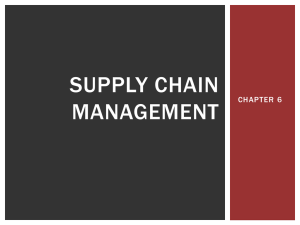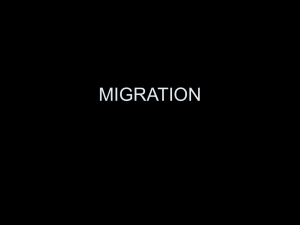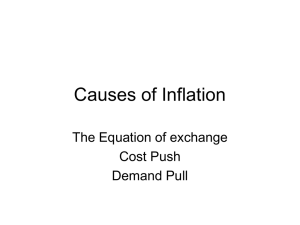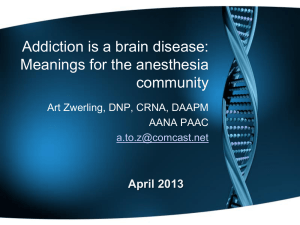The time has come to acknowledge 12 Step Recovery as
advertisement
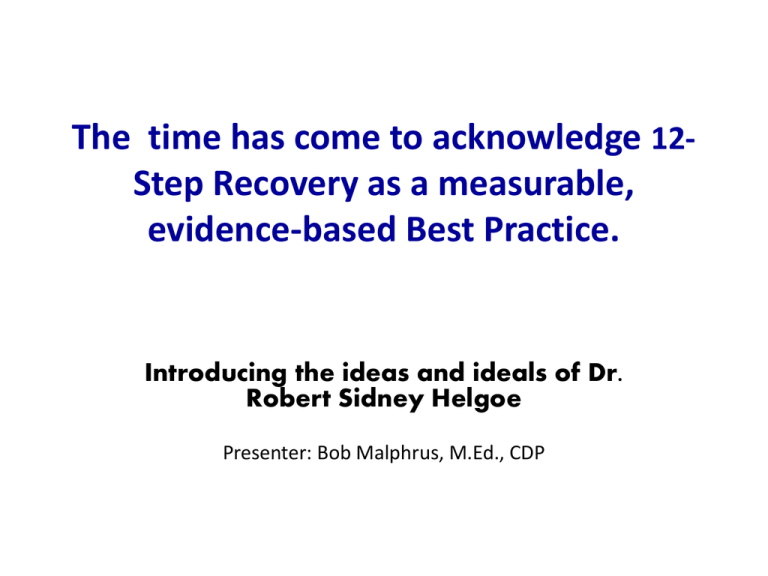
The time has come to acknowledge 12Step Recovery as a measurable, evidence-based Best Practice. Introducing the ideas and ideals of Dr. Robert Sidney Helgoe Presenter: Bob Malphrus, M.Ed., CDP A quick lesson on the dialect of the Pacific Northwest. fir = for (unless the conversation is about forests or firewood). git = get cot = caught warsh = wash Warshington = Washington The privilege of presenting About Robert S. Helgoe, Ph.D. What Hazelden Publishing says about the Hierarchy of Recovery • According to psychologist Abraham Maslow, clients progress through a hierarchy of needs that begins with physiological needs and ends with self-actualization. • According to author Robert Helgoe, the process of recovery follows the same hierarchy. Clients enter recovery because they need to survive. When they maintain recovery because they wish to thrive, they have taken an important step toward self-actualization. • Hierarchy of Recovery explores these principles in an engaging discussion. Tools such as personal inventories and checklists help you pinpoint where your clients are within the hierarchy. By knowing this, you know how to help them achieve the next level. • In this age of accountability, measuring progress scientifically instead of subjectively is essential for treatment providers. This innovative measuring tool makes it possible. • American Society of Addictive Medicine (ASAM) “short” definition of Addiction • “Addiction is a primary, chronic disease of brain reward, motivation, memory and related circuitry. Dysfunction in these circuits leads to characteristic biological, psychological, social and spiritual manifestations. This is reflected in an individual pathologically pursuing reward and/or relief by substance use and other behaviors.” • “Addiction is characterized by inability to consistently abstain, impairment in behavioral control, craving, diminished recognition of significant problems with one’s behaviors and interpersonal relationships, and a dysfunctional emotional response. Like other chronic diseases, addiction often involves cycles of relapse and remission. Without treatment or engagement in recovery activities, addiction is progressive and can result in disability or premature death.” National Institute on Drug Abuse (NIDA) “ What is drug addiction?” • “Addiction is defined as a chronic, relapsing brain disease that is characterized by compulsive drug seeking and use, despite harmful consequences. It is considered a brain disease because drugs change the brain—they change its structure and how it works. These brain changes can be long-lasting, and can lead to the harmful behaviors seen in people who abuse drugs.” Here is a thought….. Based on the ASAM and SAMSHA definitions of addiction, what type of care construes an evidencebased Best Practice? • Perhaps the most compelling evidence will reveal itself when research focuses on an addicts readiness, willingness and ability to re-engage in the recovery process after experiencing a relapse. • With addictions defined as relapsing conditions, doesn’t it make more sense to focus on what happens after a relapse as the best indicator of duration and long term success? • After all, recovery is a process……Let’s see how recovery is defined on a federal level. The Substance Abuse, Mental Health Service Administration’s (SAMHSA) working definition of recovery from substance use disorder and mental disorders is: • “A process of change through which individuals improve their health and wellness, live a self-directed life, and strive to reach their full potential.” SAMHSA 12-22-11 Recovery Oriented System of Care (ROSC) from the Addiction Technology Transfer Center Network (ATTC) says: • “Recovery community/peer involvement: • A ROSC includes members of the recovery community in the design of systems, services, and supports. People in recovery and their family members, caregivers, significant others, friends, and other allies are included among decision-makers, and have a meaningful role in service design, provision, and quality improvement. Peer-to-peer recovery support services are included in the array of services offered.” Definition of Recovery from the Hierarcy of Recovery • “The American Heritage Dictionary lists several definitions for the word recovery, the first is; ‘the getting back of something lost.’ • “In the model of recovery being offered here, the ‘something lost’ is the patient’s ability to be self actualizing.” Robert S. Helgoe With definitions in place… • Let us move forward and explore how 12 Step oriented recovery tools can be effectively employed to encourage sobriety and enrich recovery. How and why the 12 Steps work, according to Robert Helgoe • The AAA cycle of change (page 34 in the book). • Three cycles of admission, asking for help and enacting change. • “The 12 Steps teach people how to ask, admit and act.” Clients and their families tend to be unfamiliar with this process. (process vs. magic moment). • Opposite of the AAA cycle is DIP. What is DIP? • The Denial / Insisting / Passivity process. • “The DIP process describes relapse.” • “People in danger of relapse are in denial, insisting on their own way, and showing passivity about most things.” • This leads to our next ‘Helgoeism’ which is…. The Push – Pull Model of Recovery • This model distinguishes between short and longer term recovery. (chapter 3 in the book) • Short term recovery is the PUSH phase. • “People in the first, or push phase, are fueled by the basic motivation of avoiding the consequences of drinking and drugging. • “They are ‘pushed’ through their recovery activities by memories of the past…..” • “People may adopt this Push orientation for the duration of a long but unhappy recovery.” The Push – Pull Model • “The pull phase….is marked by an enlarged outlook on the future.” • “People are….pulled into experiences and behaviors in pursuit of new goals.” • “Recovery is more value-based than fear-based. • The possibility of a better future provides a positive pull. • “In Pull models (such as Maslow’s works), something called ‘potential ‘or ‘wholeness ‘ is the yardstick of measurement. • It provides a way to measure the effectiveness of 12 Step Recovery as a Best Practice model. (Helgoe workbook) So how do we really know when the external push is being replaced by an inner pull? Admission versus Acceptance “When we admit something we still continue to fight it, but when we accept it, there is no longer a desire to fight it.” Louise R. The phenomenon of acceptance is the end-product of effective grief processing. Dr. Helgoe provides a “List of Losses that focuses on losses directly attributed to drinking and drugging. This list is available in the Hierarchy of Recovery workbook. List of Needs and Desires • Here is some food for thought. If recovery is presented from the standpoint of abundance rather than (human) sacrifice…..it becomes a more attractive option. • Robert Helgoe created a list of Needs and Desires which clients use to mark areas of satisfaction and areas of need. It provides a way to track progress in their effort to satisfy needs and desires. The list is found in the Hierarchy of Recovery workbook. It is based on Maslow’s Hierarchy of Needs. Where Push becomes Pull Is it possible to measure the Pull? • According to Robert Helgoe, it is, and the means to do so has been around a long time. • Let’s turn to “the Promises” as defined by the Big Book of Alcoholics Anonymous. (page 69 in the Helgoe book) • There are 13 promises which; “are stated in the form of can, will, or discover rather than shoulds, oughts or musts. • As such, these provide a “measuring stick” for long term recovery. They also provide a way to determine the viability of 12 step recovery as a Best Practice. The Promises Checklist • Appendix B in Hierarchy of Recovery presents the Promises Checklist. This tool provides the client with an opportunity to subjectively measure their recovery progress around the 13 benchmarks defined in the Promises from one week to the next. • A working version of the Promises Checklist is found it the Hierarchy of Recovery workbook. This is where we need more focus “from surviving to thriving” • “Long term recovery brings more than continued abstinence; at some point during recovery , many people gain an entirely new outlook on life.” Robert S. Helgoe Now…what about that elephant in the counseling office and the other one in the group room? Regarding the topic of Spirituality “…..You see, alcohol in Latin is "spiritus," and you use the same word for the highest religious experience as well as for the most depraving poison. The helpful formula therefore is: spiritus contra spiritum.” (interpretation: Higher Power opposes alcoholism) The passage above comes from Carl Jung’s response to a letter from Bill Wilson, co-founder of AA in 1961. Going further back in history “Espiritum vinci espiritus.” Higher Power overcomes alcoholism. Marcus Aurelius Antoninus (121-180 AD) Army General, Philosopher and Caesar of Rome For a deeper understanding of the AA connection with spirituality. • Read pages 9 –14 in the 4th Edition of the Big Book, the Basic Text for Alcoholics Anonymous. • The following definition was given to me by Jim S., an AA member and retired substance abuse counselor: “Religion is for those who wish to escape the fires of hell. Spirituality is for those who have experienced the fires of hell and have no desire to return there.” A Vision • Can you imagine living in a community where substance abuse and mental health services are offered in the same way that dental and other health services are…. where people feel comfortable returning for assistance the same way they do when a tooth ache occurs or they need a spine adjustment? • It is time for us to make this happen.



